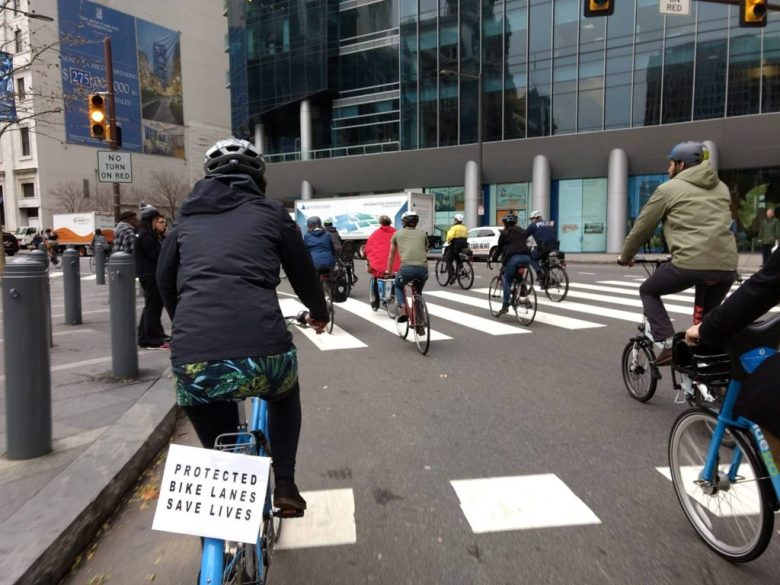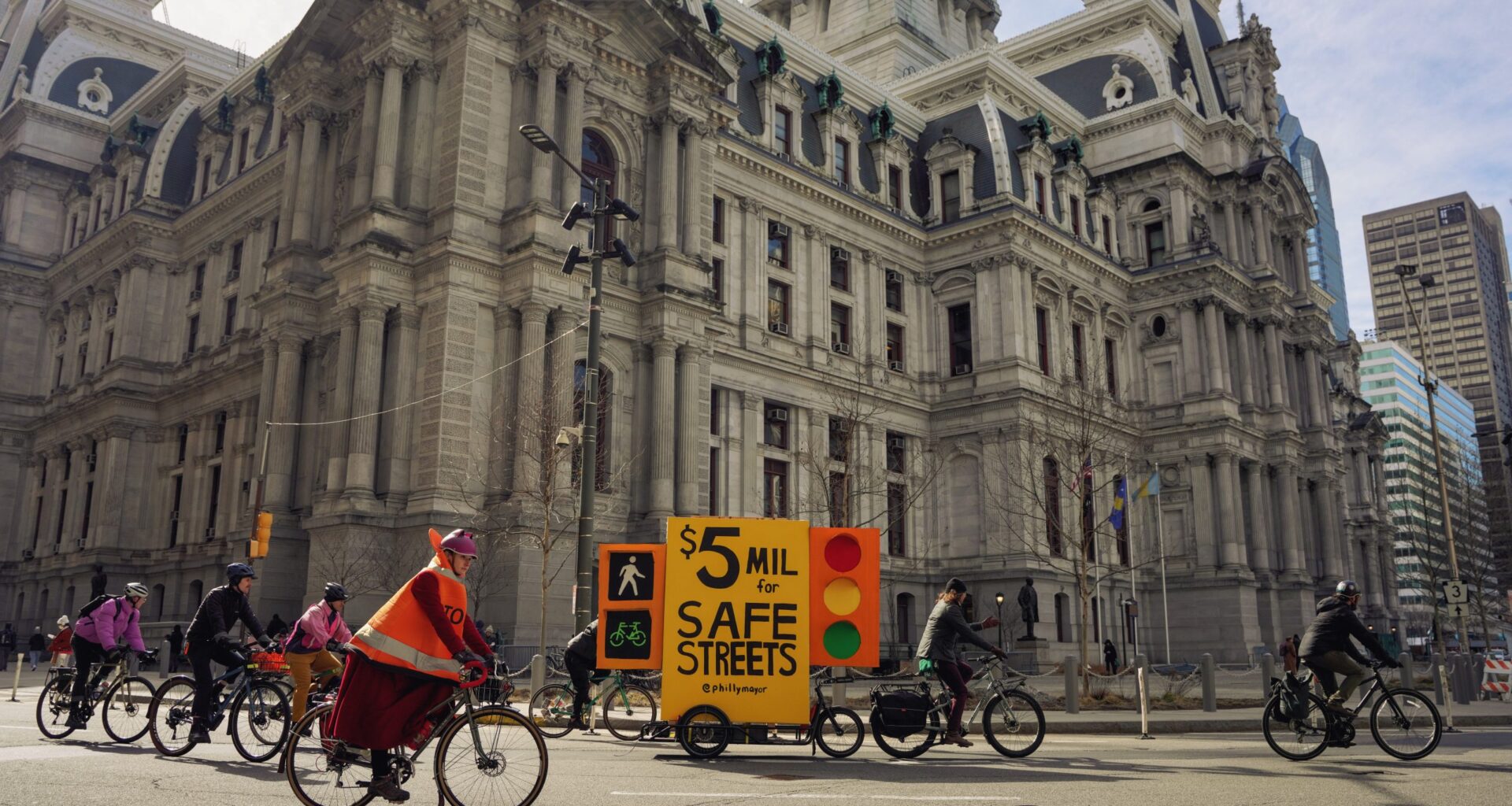PennDOT has begun a repaving project that will create a new bike lane encircling City Hall, with the goal of improving safety for cyclists and pedestrians and helping calm traffic in the busy heart of Center City.
The new lane will be marked with a green pavement coating and separated from traffic with flexible plastic posts, according to a Streets Department engineering plan. It will hug the sidewalk almost all the way around Penn Square, the site of City Hall and Dilworth Plaza.
To make room for the bike lanes, the project will remove one car lane from most of the roadway on three sides of the square. That will also result in shorter street crossing distances for pedestrians and wheelchair users.
Currently there’s only a bike lane on the west side of the square, next to Dilworth Plaza. It ends as the road begins to curve east, and cyclists must either enter the hectic car lanes on the south side of the square or cross three lanes of traffic to reach 15th Street.
 Cyclists round the curve at the southeast corner of Penn Square, where PennDOT plans to install a new bike lane. (Joe Russell/Bicycle Coalition of Greater Philadelphia)
Cyclists round the curve at the southeast corner of Penn Square, where PennDOT plans to install a new bike lane. (Joe Russell/Bicycle Coalition of Greater Philadelphia)
City Hall’s current traffic pattern “is dangerous for pedestrians and people who are on a bike there. It’s like a death trap,” said Jessie Amadio, an organizer at Philly Bike Action. The project is “definitely one of those things that’s just going to add a major quality-of-life improvement for literally everybody who has to be in that area — and that is a lot of people.”
She noted that two people were struck in a hit-and-run car crash on the east side of City Hall in November, and one of them had a leg amputated.
PennDOT started the work Tuesday with the milling of asphalt road surfaces, even though City Council has yet to approve the bike lane, Amadio said. A bill sponsored by Councilmember Jeffery Young that would authorize it is set for an initial committee hearing next Monday.
A last-minute addition
Earlier this year bike advocates learned that PennDOT was planning imminent repaving work, and they lobbied City Council to authorize a bike lane in time for it to be incorporated into the project.
“This is a real opportunity, especially because it’s a PennDOT road. When PennDOT repaves one of their roads, they pay for it,” Amadio said. “So it’s super important for Philly, which does have limited resources, to not waste an opportunity like this to get improved infrastructure paid for by the state.”
Young introduced a bill removing car lanes and adding bike lanes on the three short sections of road around City Hall — South Penn Square, East Penn Square/Juniper Street, and a portion of JFK Boulevard. Part of the lane on JFK will be near the center of the road, between diverging car lanes.
The bill did not get a hearing before council went on summer break, but the introduction was enough to let PennDOT move ahead and finalize a design in cooperation with the city.
“Penn Square was a late addition to PennDOT’s paving season,” Young said. “As a good-faith measure, we introduced the legislation, and thanks to PennDOT’s flexibility, the paving was scheduled for early fall. I look forward to hearing from all parties and stakeholders as we work toward improving traffic safety.”
The lane will be considered a pilot until Young’s bill becomes law, Amadio said. In the event that the measure doesn’t pass and get the mayor’s signature, “Philly Bike Action will be out there in the streets, making sure they don’t rip out the bike lane,” she said with a laugh.
The city generally encourages bicyclists to use smaller streets with bike lanes or markings, such as 13th and 15th streets, rather than arterials without dedicated bike lanes, like Broad Street. On Market Street there is a bike lane west of City Hall but not to the immediate east.
However, Amadio said she and other cyclists can’t avoid riding near City Hall when they’re heading to certain destinations, which the new lane will make a safer experience. She also noted that new elevated bike lanes are currently under construction on Market Street between 2nd and 6th streets in Old City.
“The original proposal for that was to go all the way to City Hall, and it’s something that I think there is still an eventual future appetite for,” she said. “We’re just building the pieces until the whole network gets there one day.”
An ongoing road safety campaign
The City Hall lane is the latest of several recent projects to expand bicycling infrastructure around the city. A new protected bike lane recently debuted on 47th Street in West Philly, following the installation of a similar lane on 48th Street last year.
In May, the city opened a new half-mile segment of the Schuylkill River Trail as part of a plan to connect Center City with South Philadelphia’s Grays Ferry neighborhood.
Advocates are now focused on improving road and sidewalk conditions in Fairmount Park, following a speeding crash on Sept. 2 in which cyclist Harry Fenton died.
They’re calling on the city to lower speed limits in the park to 25 mph, install traffic-calming measures and two roundabout intersections on Belmont Avenue, and repair crumbling cycling and walking paths.
Some roads in the park are owned by the city and some by the state, which makes it hard to advance roadwork and redesigns, but Philly Bike Action and other groups want to begin the push to improve conditions there, Amadio said.
“There’s things that we could be doing to prevent this kind of aggressive driving, or to close certain roads to through traffic so people aren’t using it to cut through the park. Maybe they can just use the roads to access park amenities, which is a totally different type of traffic,” she said. “The point is to just start having this conversation.”
The city also has plans to install concrete dividers along the Spruce and Pine street bike lanes, but the status of that project remains unclear as a lawsuit over loading zones on those roads works its way through the courts.
